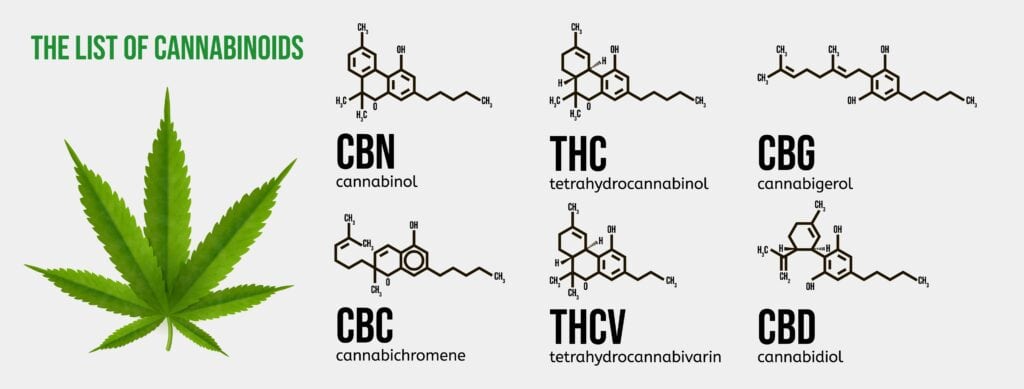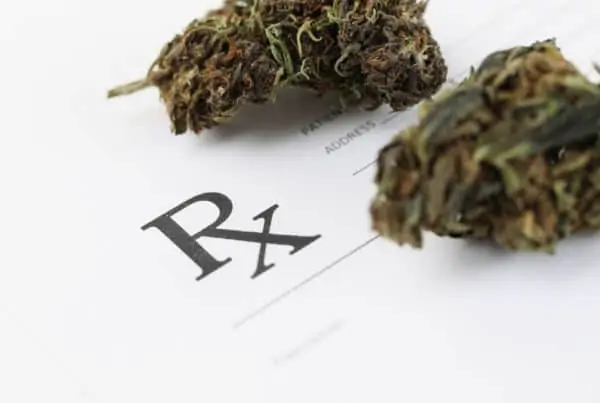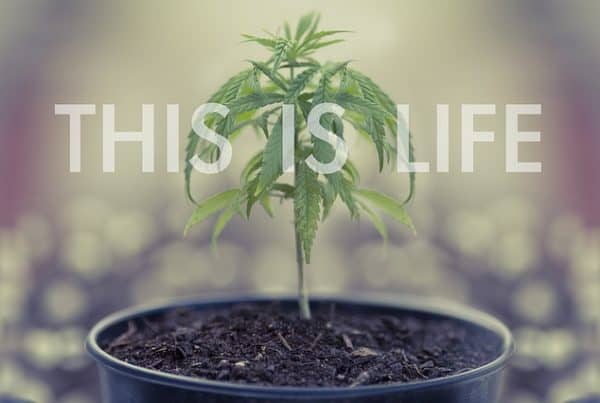TABLE OF CONTENTS
Some of the most exciting findings in recent years have been the discovery of the many different compounds found inside of the cannabis plant, and the different effects each compound can have on the user. These are known as cannabinoids.
Delta-9-Tetrahydrocannabinol or (THC) is the most widely known compound in the cannabis plant, and it is responsible for many of the effects experienced by the cannabis user such as:
-Mild to moderate pain relief
-Appetite stimulation
-Relief from insomnia
-Anti-depressant effects
All cannabis, whether it is industrial hemp, or the drug marijuana, contains at least some THC. But industrial hemp cannabis contains such a tiny amount of THC that it cannot get a user “High”.
The dried flower tops of the female cannabis plant however can contain as high as 25% THC, creating a mind altering psychoactive experience for the user.
THC though, in high amounts, can at times cause paranoia-like symptoms in users and therefore it is sometimes recommended to try strains with a lower THC level, and a higher amount of other compounds, such as CBD. Patients with a pre-disposition to schizophrenia and anxiety disorders should avoid cannabis with high-THC levels.
CBD, or cannabidiol (CBD) is a cannabinoid found in cannabis. It is a major constituent of the plant, representing up to 50% in its extracts. Medically, it has been shown to relieve anxiety, inflammation, convulsion, and nausea.

Cannabinoid CBD Has Been Found to Inhibit the Growth of Cancer Cells
This has led to a recent explosion of interest in CBD amongst pharmaceutical companies, all trying to capitalize on the findings.
As far back as November 2007, it was reported that CBD reduces growth of aggressive human breast cancer cells and reduces their ability to grow and multiply. CBD has been found to also reduce muscle spasms and provide pain relief in patients.
CBD is often found in large quantities in hashish, or cannabis resin. Although in herbal cannabis, CBD is typically found in low amounts.
CBD alone is not psychoactive, and therefore many patients are finding that by choosing a strain of cannabis that has lower levels of THC, and higher levels of CBD, they are more relaxed, and do not experience and paranoia or anxiety like they may with high THC strains.
Users often report that CBD can postpone the initial high feeling that is normally felt almost instantly, but that strains with high CBD also tend to last longer than those without it.
Some of the popular strains that are high in CBD are “Sour Tsunami”, “Harlequin”, and “Cannatonic”. Because CBD has a calming effect and helps lower the anxiety that some users get from high THC strains it is one of the most helpful tips that a Budtender can explain to a medical marijuana patient.
Compound Commonly Found in Cannabis Today is CBN, or “Cannabinol”
CBN is produced as THC degrades or oxidizes. In fresh cannabis buds CBN only exists in small amounts, while it is found in higher amounts in Hashish. CBN is usually formed when THC is exposed to UV light and oxygen over time.
CBN generally makes a patient feel sleepy, disoriented, or “couch locked”. Medically, CBN’s primary effects are as an anti-epileptic, and for relief from ocular pressure for patients with glaucoma.
CBN has a small amount of psychoactive properties, only about 10% of the strength of THC. Cannabinol has been found to reduce heart rate in users. But because CBN makes users feel groggy, many patients do not like strains with too much CBN in them.
CBN levels can be kept to a minimum by storing cannabis products in a cool, dark, airtight environment.
Cannabinoids are a group of compounds found in the cannabis plant that offer a wide range of potential health benefits.
Research has shown that cannabinoids may have therapeutic effects, such as helping to reduce pain, inflammation and anxiety, as well as providing relief from symptoms associated with certain medical conditions.
Additionally, some cannabinoids are shown to inhibit cancer cell growth and foster healthier cell growth for overall better health.
With more patients turning to natural medicine and other alternative medical therapies, understanding the effects of these powerful compounds is more important than ever.
Different Cannabinoids and Their Benefits
The cannabis plant contains compounds called cannabinoids. They interact with the Endocannabinoid System, which controls a number of physiological and mental functions in the body. There are several cannabinoids, each with special qualities of their own.
THC
Tetrahydrocannabinol, or THC, is a cannabinoid that occurs naturally in cannabis plants. It is the most well-known and prevalent chemical in cannabis and is primarily responsible for the euphoric effects that marijuana users encounter when consuming or smoking it.
Depending on the concentration rate, THC can have a variety of effects, including increased hunger, relaxation, euphoria, and mental alertness.
Physiological effects can include lessened pain intensity, enhanced muscular control, decreased chemotherapy-related nausea, and more.
THCA
THCA also known scientifically as tetrahydrocannabinolic acid, is a naturally-occurring cannabinoid found in the cannabis plant. It is an inactive precursor to THC and is also known as the raw form of THC.
Some of its beneficial effects include reducing inflammation and relieving nausea. Because it is still in its acidic form when consumed, it must be decarboxylated (heated) in order to become active.
Ultimately, THCA has many potential therapeutic benefits that are currently being studied in greater detail by scientists across the globe, looking for ways to leverage this impressive cannabinoid for relief and wellness.
CBD
Cannabidiol, also known as CBD, is the second most prevalent cannabinoid after THC (tetrahydrocannabinol). CBD has been studied for its potential impact on a variety of illnesses, including the management of chronic pain, inflammation, and anxiety.
While CBD does not have the same intoxicating effects as THC, it has been discovered to interact with bodily receptors that may help with pain alleviation, reduced inflammation, and a calmer mood.
CBDA
The cannabinoid CBD is present in cannabis in an acidic form called CBDA prior to decarboxylation. Cannabis is no longer in its raw state after being cooked and “decarbed,” and the components in the plant naturally go through a number of chemical modifications.
Many potential medical applications and health advantages of CBDA exist. According to scientific study, this acidic cannabinoid may be employed in the following frequently occurring ways:
- Anti-inflammatory
- Anti-tumor with the ability to reduce both benign and malignant tumors and maybe stop the spread of breast cancer cells
- CBDA may be highly helpful in treating anxiety and nausea since it acts on serotonin receptors.
CBN
CBN, or cannabinol, is another popular cannabinoid found in cannabis. While its effects are similar to other cannabinoids like THC and CBD, it's known for being a milder, more sedating experience with relaxing qualities.
What’s more, due to its low psychotropic power and anti-inflammatory properties, CBN is gaining traction as an alternative treatment option for medical conditions and ailments including pain, insomnia, and headaches. In short, CBN is a versatile cannabinoid worth looking into if you’re exploring natural remedies to address your health needs.
Lets look at the similarities and differences of cannabinoids in cannabis. Humans have used drugs that have been derived from plants for many thousands of years to decrease and cope with pain. The way dosing for cannabis is, it makes it almost impossible to overdose on.
In 1964 THC was discovered at the Weizmann Institute of Science in Rehovot, Israel by Dr. Raphael Mechoulam. In the year 1973, scientists discovered the first opiate receptors in the human brain.
Ancient Greece Used Opiates for Pain
Opioid receptors are distributed widely in the brain and can be found in the digestive tract and spinal cord. Opium is found in the seedpod of poppy plants.
In 1975 scientists discovered that the human brain had what are known as “endogenous opiates”, commonly known today as “endorphins”.
Cannabinoids in Cannabis
American researcher Allyn Howlett and her graduate student William Devane discovered the first cannabinoid receptors in the brain in 1988. They named them cannabinoid 1 receptors (CB1). In 1992 researchers in Israel found an endogenous cannabinoid and proceeded to name it N-arachidonoyl ethanolamine or anandamide.
In 1993 scientists found cannabinoid receptors in the immune system (CB2), and subsequently discovered a second endocannabinoid called 2-arachidonoyl glycerol.
So far there have been five endocannabinoids discovered, although as far as medicinal value, the first two found, anandamide and 2-AG appear to have the most importance.
Scientists have since realized that CB1 receptors are found mostly on neurons in the spinal cord, brain, and peripheral nervous system. This very reason explains the role of cannabinoids in pain modulation, memory processing, and motor control.
CB2 receptors are located mainly in immune cells such as the spleen and tonsils. An amazingly extraordinary fact is that in the human body there are more receptors for cannabinoids than for any other substance.
In the middle area of the human brain there are systems that are critical to keep humans alive, such as heartbeat and breathing. Cannabinoid receptors are almost completely missing in this area of the brain, whereas opioids have a profound affect on the midbrain.
“
There are over 300,000 jobs in the cannabis industry. CTU trained me for one of them!

Makes $24.50 @ THC +
This explains why cannabis is so safe and does not cause overdoses and deaths like opioid-based medicines so commonly do.
Final Thoughts on Cannabinoids
Other diverse cannabinoids include CBC, CBG and CBV. There are also several benefits associated with each. If you want to learn more about these diverse cannabinoids, visit the Cannabis Training University to enroll in our prestigious online cannabis courses.
Cannabinoids FAQ's
What are cannabinoids?
The cannabis plant (Cannabis sativa) naturally contains substances called cannabinoids. They have an effect on the endocannabinoid system of the body, which controls a number of physiological functions including pain, mood, appetite, and sleep. Tetrahydrocannabinol (THC) and cannabidiol are the two most well-known cannabinoids (CBD)
What is the difference between THC and CBD?
The main psychoactive ingredient in cannabis, THC, is what gives users of marijuana a “high.” Research has demonstrated that it may have therapeutic advantages, including pain alleviation and hunger stimulation. Contrarily, non-psychoactive CBD has been investigated for possible anti-inflammatory, anxiolytic, and anti-epileptic effects.
How do cannabinoids work in the body?
The body's endocannabinoid system (ECS), which is made up of enzymes that produce and breakdown endocannabinoids, endogenous cannabinoids (endocannabinoids), and cannabinoid receptors (CB1 and CB2). Cannabinoids interact with this system. In the brain, THC primarily binds to CB1 receptors, but CBD interacts more intricately with the ECS to affect the function of other receptors and neurotransmitters.
What are the potential therapeutic benefits of cannabinoids?
Researchers have looked into the possible medicinal uses of cannabinoids for a range of ailments, such as:
Chronic pain: Research has indicated that THC and CBD may be able to help with the chronic pain brought on by diseases like multiple sclerosis and arthritis.
Epilepsy: The FDA has approved CBD for the treatment of Lennox-Gastaut syndrome and Dravet syndrome, two uncommon types of epilepsy.
Anxiety: The anxiolytic qualities of CBD have been studied, and it may be able to lessen anxiety symptoms.
Inflammation: THC and CBD have both shown anti-inflammatory properties that make them potentially useful in the treatment of inflammatory bowel disease and Crohn's disease.
Nausea and Vomiting: THC has been used to treat vomiting and nausea brought on by chemotherapy.
How can cannabinoids be consumed?
There are several ways that cannabinoids can be eaten, such as:
-Vaping or smoking dried flower or concentrates of cannabis.
-Taking candies, pills, or oils infused with cannabis orally.
-Using cannabis sprays or tinctures under the tongue to facilitate absorption.
-Dousing the skin with creams, lotions, or balms containing cannabis

Fred Hernandez
Fred Hernandez is a highly accomplished and versatile writer, boasting an extensive background in the cannabis industry. With an in-depth understanding of various sectors including cultivators, processors, retailers, and brands, Fred's expertise spans across the entire cannabis landscape. As a prominent contributor to CTU, he consistently delivers insightful articles exploring the latest developments, news, and regulations shaping the cannabis industry. Whether it's delving into the intricacies of cannabis products, cannabis strain reviews, or providing comprehensive analyses of cannabis laws, or sharing expert insights on cannabis cultivation techniques, Fred's wealth of knowledge positions him as an invaluable writer and educator for all cannabis-related subjects.












 Jeff was involved in an accident where he endured a traumatic brain injury. He had a week-long stay in ICU where brain surgeons
Jeff was involved in an accident where he endured a traumatic brain injury. He had a week-long stay in ICU where brain surgeons  100% risk free money back guarantee within 48 hours after purchase if student has not completed any of the courses or exams.
100% risk free money back guarantee within 48 hours after purchase if student has not completed any of the courses or exams.